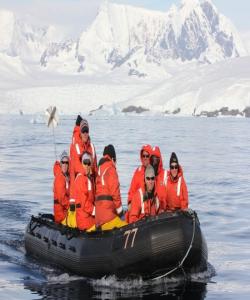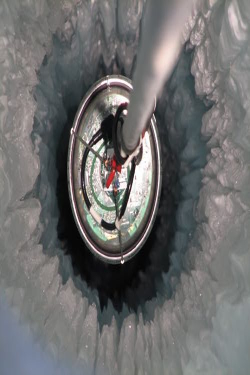Permafrost and Community
What Are They Doing?
 The team just arrived to Point Barrow and learned about the area and the protocol for the day. Photo by Elizabeth Eubanks.
The team just arrived to Point Barrow and learned about the area and the protocol for the day. Photo by Elizabeth Eubanks.
Alaska’s land, water, plants, wildlife, and seasons are undergoing a great upheaval, and its people, especially the tribal communities living in remote villages are directly and severely impacted by these changes. The project will provide the traditionally-underserved tribal communities of the Upper Kuskokwim region the motivation, resources, climate science knowledge and skills to study the impact of climate change on their tribal way of life and environment.
The project will establish local climate and permafrost observation system and map land cover and permafrost in the Upper Kuskokwim region. It will also develop a geo-hazard map for the region to facilitate safe subsistence and recreational practices and land use. The data, knowledge, and skills gained through this project will benefit the tribal communities in implementation of safe land use practices, and planning for the future.


 Willows along the bank of Toolik Lake. Toolik Field Station, Alaska. Photo by Regina Brinker.
Willows along the bank of Toolik Lake. Toolik Field Station, Alaska. Photo by Regina Brinker.

 Akmaliighaq (least auklets) at sunset. Kitnkik, east of Savoonga, St. Lawrence Island, Alaska. Photo by Lisa Sheffield Guy.
Akmaliighaq (least auklets) at sunset. Kitnkik, east of Savoonga, St. Lawrence Island, Alaska. Photo by Lisa Sheffield Guy.

 A Chrysaora melanaster jellyfish was obtained from a tow net.
A Chrysaora melanaster jellyfish was obtained from a tow net.

 Karl Horeis: "The ground out here is often covered with many tiny plants. Some look like tiny ferns while others look like branches from little cedar trees. Note the ripe blueberries in the foreground, a favorite among bears (and archaeologists)." Raven Bluff, Alaska. Photo by Karl Horeis.
Karl Horeis: "The ground out here is often covered with many tiny plants. Some look like tiny ferns while others look like branches from little cedar trees. Note the ripe blueberries in the foreground, a favorite among bears (and archaeologists)." Raven Bluff, Alaska. Photo by Karl Horeis.

 Nell Herrmann and scientists explore the waters on a zodiac near the Western Antarctic Peninsula. Photo by Nell Herrmann.
Nell Herrmann and scientists explore the waters on a zodiac near the Western Antarctic Peninsula. Photo by Nell Herrmann.

 A DOM (Digital Optical Module) being lowered into the ice. Photo by Jim Haugen.
A DOM (Digital Optical Module) being lowered into the ice. Photo by Jim Haugen.

 Carol Costanza helps recover Laurie II AWS. Photo by Elin McIlhattan
Carol Costanza helps recover Laurie II AWS. Photo by Elin McIlhattan

 Sea ice in the the Ross Sea. Photo by Lollie Garay.
Sea ice in the the Ross Sea. Photo by Lollie Garay.
 PIPERS logo
PIPERS logo
 An underwater view of a CTD (conductivity, temperature, and depth instrument). Photo by Bill Schmoker.
An underwater view of a CTD (conductivity, temperature, and depth instrument). Photo by Bill Schmoker.
